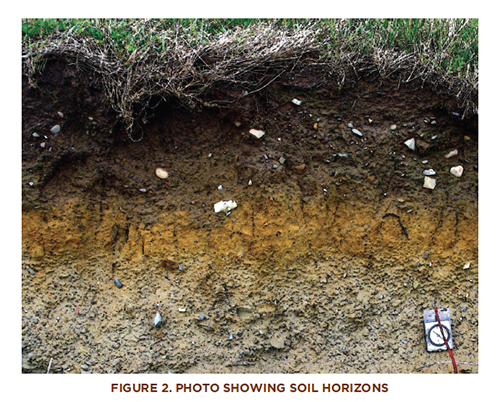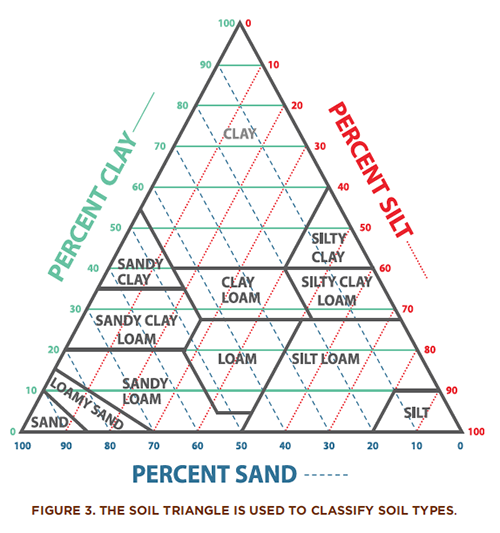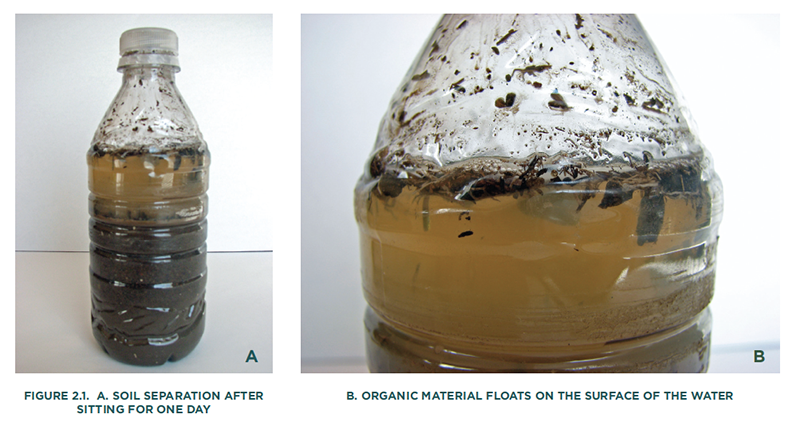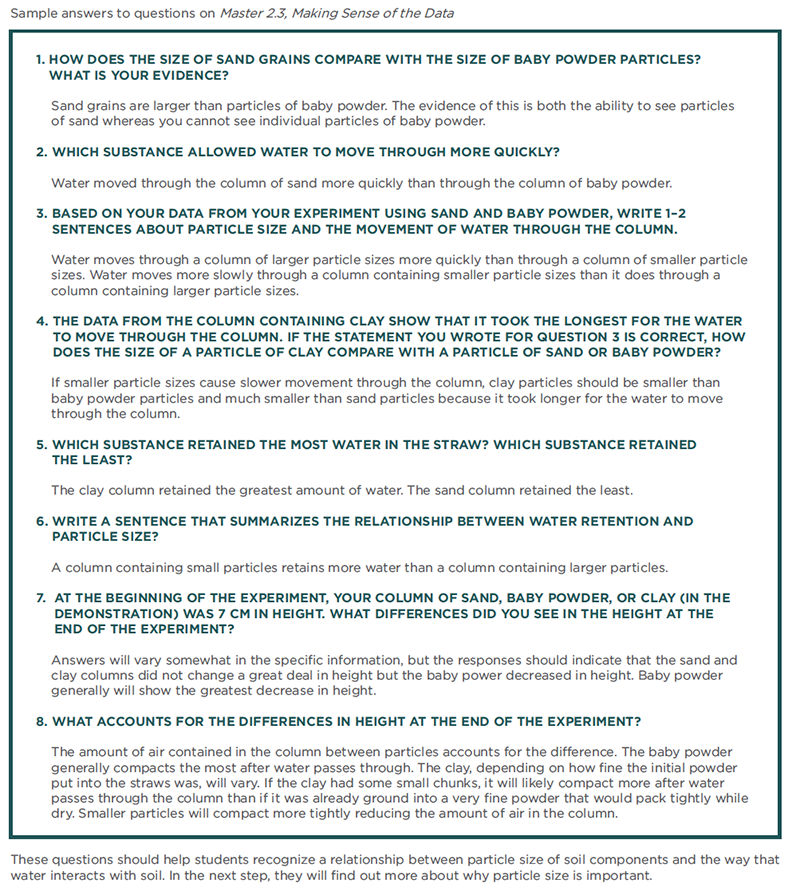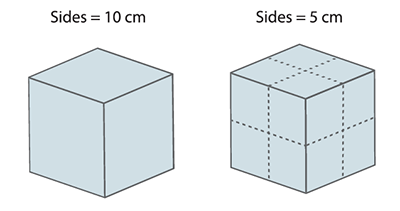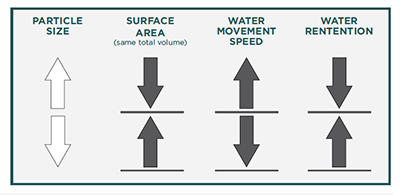Properties of Soils (Grades 9-12)
Students examine different types of soil that have been mixed with water and allowed to settle. Next, they work with a soil model to investigate its components (sand, silt, and clay) and learn how the properties of these components affect the passage or retention of water through the soil and the amount of air in the soil.
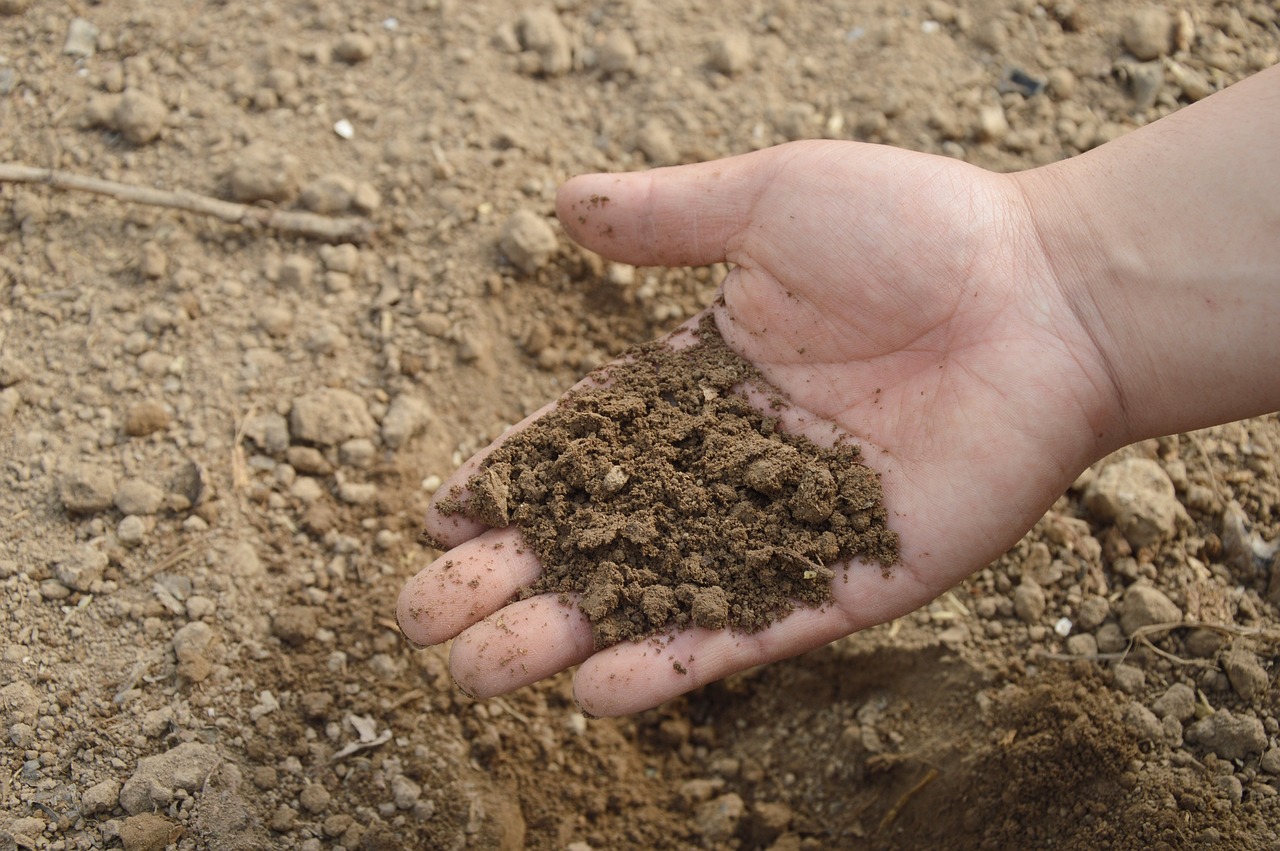
Background
Lesson Activities
Recommended Companion Resources
Credits
Author
Nutrients for Life Foundation
Sources
- Nutrients for Life Foundation
- BSCS-Biological Science Curriculum Study
- Reviewed by Smithsonian Institution
Standards
Texas Content Area Standards
-
Principles of Agriculture, Food, and Natural Resources: 130.2.c.1
The student demonstrates professional standards/employability skills as required by business and industry. The student is expected to:
- Principles of Agriculture, Food, and Natural Resources: 130.2.c.1.B: apply competencies related to resources, information, interpersonal skills, problem solving, critical thinking, and systems of operation in agriculture, food, and natural resources.
-
Principles of Agriculture, Food, and Natural Resources: 130.2.c.6
The student demonstrates appropriate personal and communication skills. The student is expected to:
- Principles of Agriculture, Food, and Natural Resources: 130.2.c.6.A: demonstrate written and oral communication skills appropriate for formal and informal situations such as prepared and extemporaneous presentations.
- Principles of Agriculture, Food, and Natural Resources: 130.2.c.6.B: demonstrate effective listening skills appropriate for formal and informal situations.
-
Principles of Agriculture, Food, and Natural Resources: 130.2.c.10
The student develops technical knowledge and skills related to soil systems. The student is expected to:
- Principles of Agriculture, Food, and Natural Resources: 130.2.c.10.A: identify the components and properties of soils.
- Principles of Agriculture, Food, and Natural Resources: 130.2.c.10.B: identify and describe the process of soil formation.
- Principles of Agriculture, Food, and Natural Resources: 130.2.c.10.C: conduct experiments related to soil chemistry.
-
World Geography Studies: 113.43.d.21
Social studies skills. The student applies critical-thinking skills to organize and use information acquired through established research methodologies from a variety of valid sources, including technology. The student is expected to:
- World Geography Studies: 113.43.d.21.F: formulate and communicate visually, orally, or in writing a claim supported by evidence and reasoning for an intended audience and purpose
-
Economics with Emphasis on the Free Enterprise System and Its Benefits: 113.31.d.21
Social studies skills. The student applies critical-thinking skills to organize and use information acquired through established research methodologies from a variety of valid sources, including technology. The student is expected to:
- Economics with Emphasis on the Free Enterprise System and Its Benefits: 113.31.d.21.F: formulate and communicate visually, orally, or in writing a claim supported by evidence and reasoning for an intended audience and purpose
-
English I: 110.36.c.1
Developing and sustaining foundational language skills: listening, speaking, discussion, and thinking--oral language. The student develops oral language through listening, speaking, and discussion.
- English I: 110.36.c.1.A: engage in meaningful and respectful discourse by listening actively, responding appropriately, and adjusting communication to audiences and purposes;
- English I: 110.36.c.1.B: follow and give complex oral instructions to perform specific tasks, answer questions, or solve problems and complex processes;
- English I: 110.36.c.1.D: participate collaboratively, building on the ideas of others, contributing relevant information, developing a plan for consensus building, and setting ground rules for decision making
-
English I: 110.36.c.4
Comprehension skills: listening, speaking, reading, writing, and thinking using multiple texts. The student uses metacognitive skills to both develop and deepen comprehension of increasingly complex texts.
- English I: 110.36.c.4.F: make inferences and use evidence to support understanding
- English I: 110.36.c.4.G: evaluate details read to determine key ideas
-
English I: 110.36.c.5
Response skills: listening, speaking, reading, writing, and thinking using multiple texts. The student responds to an increasingly challenging variety of sources that are read, heard, or viewed.
- English I: 110.36.c.5.E: interact with sources in meaningful ways such as notetaking, annotating, freewriting, or illustrating
- English I: 110.36.c.5.F: respond using acquired content and academic vocabulary as appropriate
-
English II: 110.37.c.4
Comprehension skills: listening, speaking, reading, writing, and thinking using multiple texts. The student uses metacognitive skills to both develop and deepen comprehension of increasingly complex texts.
- English II: 110.37.c.4.F: make inferences and use evidence to support understanding
- English II: 110.37.c.4.G: evaluate details read to determine key ideas
-
English II: 110.37.c.1
Developing and sustaining foundation language skills: listening, speaking, discussion, and thinking--oral language. The student develops oral language through listening, speaking, and discussion.
- English II: 110.37.c.1.A: engage in meaningful and respectful discourse when evaluating the clarity and coherence of a speaker's message and critiquing the impact of a speaker's use of diction and syntax
- English II: 110.37.c.1.B: follow and give complex oral instructions to perform specific tasks, answer questions, or solve problems and complex processes
- English II: 110.37.c.1.D: participate collaboratively, building on the ideas of others, contributing relevant information, developing a plan for consensus building, and setting ground rules for decision making
-
English III: 110.38.c.1
Developing and sustaining foundational language skills: listening, speaking, discussion, and thinking--oral language. The student develops oral language through listening, speaking, and discussion.
- English III: 110.38.c.1.A: engage in meaningful and respectful discourse when evaluating the clarity and coherence of a speaker's message and critiquing the impact of a speaker's use of diction and syntax
- English III: 110.38.c.1.B: follow and give complex instructions, clarify meaning by asking pertinent questions, and respond appropriately
- English III: 110.38.c.1.D: participate collaboratively, offering ideas or judgments that are purposeful in moving the team toward goals, asking relevant and insightful questions, tolerating a range of positions and ambiguity in decision making, and evaluating the work of the group based on agreed-upon criteria
-
English III: 110.38.c.4
Comprehension skills: listening, speaking, reading, writing, and thinking using multiple texts. The student uses metacognitive skills to both develop and deepen comprehension of increasingly complex texts.
- English III: 110.38.c.4.F: make inferences and use evidence to support understanding
- English III: 110.38.c.4.G: evaluate details read to understand key ideas
-
English III: 110.38.c.5
Response skills: listening, speaking, reading, writing, and thinking using multiple texts. The student responds to an increasingly challenging variety of sources that are read, heard, or viewed.
- English III: 110.38.c.5.E: interact with sources in meaningful ways such as notetaking, annotating, freewriting, or illustrating
- English III: 110.38.c.5.F: respond using acquired content and academic vocabulary as appropriate
-
English II: 110.37.c.5
Response skills: listening, speaking, reading, writing, and thinking using multiple texts. The student responds to an increasingly challenging variety of sources that are read, heard, or viewed.
- English II: 110.37.c.5.E: interact with sources in meaningful ways such as notetaking, annotating, freewriting, or illustrating
- English II: 110.37.c.5.F: respond using acquired content and academic vocabulary as appropriate
-
English IV: 110.39.c.1
Developing and sustaining foundational language skills: listening, speaking, discussion, and thinking--oral language. The student develops oral language through listening, speaking, and discussion.
- English IV: 110.39.c.1.A: engage in meaningful and respectful discourse when evaluating the clarity and coherence of a speaker's message and critiquing the impact of a speaker's use of diction, syntax, and rhetorical strategies
- English IV: 110.39.c.1.B: follow and give complex instructions, clarify meaning by asking pertinent questions, and respond appropriately
- English IV: 110.39.c.1.D: participate collaboratively, offering ideas or judgments that are purposeful in moving the team toward goals, asking relevant and insightful questions, tolerating a range of positions and ambiguity in decision making, and evaluating the work of the group based on agreed-upon criteria
-
English IV: 110.39.c.4
Comprehension skills: listening, speaking, reading, writing, and thinking using multiple texts. The student uses metacognitive skills to both develop and deepen comprehension of increasingly complex texts.
- English IV: 110.39.c.4.F: make inferences and use evidence to support understanding
- English IV: 110.39.c.4.G: evaluate details read to analyze key ideas
-
English IV: 110.39.c.5
Response skills: listening, speaking, reading, writing, and thinking using multiple texts. The student responds to an increasingly challenging variety of sources that are read, heard, or viewed.
- English IV: 110.39.c.5.E: interact with sources in meaningful ways such as notetaking, annotating, freewriting, or illustrating
- English IV: 110.39.c.5.F: respond using acquired content and academic vocabulary as appropriate
-
Range Ecology and Management: 130.19.C.5
The student analyzes the biotic and abiotic components of a rangeland. The student is expected to:
- Range Ecology and Management: 130.19.C.5.A: discuss components of rangeland with an emphasis on soil.
- Range Ecology and Management: 130.19.C.5.B: determine components of rangeland with an emphasis on topography.
- Range Ecology and Management: 130.19.C.5.C: classify range sites by soil properties.
-
Advanced Plant and Soil Science: 130.25.c.1
The student demonstrates professional standards/employability skills as required by business and industry. The student is expected to:
- Advanced Plant and Soil Science: 130.25.c.1.B: apply competencies related to resources, information, interpersonal skills, and systems of operation in plant systems.
-
World History Studies: 113.42.d.28
Social studies skills. The student understands how historians use historiography to interpret the past and applies critical-thinking skills to organize and use information acquired from a variety of valid sources, including technology. The student is expected to:
- World History Studies: 113.42.d.28.F: formulate and communicate visually, orally, or in writing a claim supported by evidence and reasoning for an intended audience and purpose
-
Advanced Plant and Soil Science: 130.25.c.6
The student analyzes plant and soil science as it relates to plant and soil relationships affecting the production of food, fiber, and other economic crops. The student is expected to:
- Advanced Plant and Soil Science: 130.25.c.6.A: explain the importance and interrelationship of soil and plants.
-
Advanced Plant and Soil Science: 130.25.c.7
The student develops scenarios for advances in plant and soil science. The student is expected to:
- Advanced Plant and Soil Science: 130.25.c.7.A: design, conduct, and complete research in a laboratory or field investigation to solve problems in plant and soil science.
- Advanced Plant and Soil Science: 130.25.c.7.B: use charts, tables, and graphs to prepare written summaries of results and data obtained in a laboratory or field investigation.
- Advanced Plant and Soil Science: 130.25.c.7.C: organize, analyze, evaluate, make inferences, and predict trends from data obtained in a laboratory or field investigation.
- Advanced Plant and Soil Science: 130.25.c.7.D: communicate valid outcomes and solutions.
-
Advanced Plant and Soil Science: 130.25.c.9
The student analyzes soil science as it relates to food and fiber production. The student is expected to:
- Advanced Plant and Soil Science: 130.25.c.9.A: explain soil formation.
- Advanced Plant and Soil Science: 130.25.c.9.B: evaluate the properties and nature of soils.
- Advanced Plant and Soil Science: 130.25.c.9.F: practice soil evaluations related to experiential activities such as land judging.
-
Biology: 112.42.c.1
Scientific and engineering practices. The student, for at least 40% of instructional time, asks questions, identifies problems, and plans and safely conducts classroom, laboratory, and field investigations to answer questions, explain phenomena, or design solutions using appropriate tools and models. The student is expected to:
- Biology: 112.42.c.1.A: ask questions and define problems based on observations or information from text, phenomena, models, or investigations
- Biology: 112.42.c.1.E: collect quantitative data using the International System of Units (SI) and qualitative data as evidence
- Biology: 112.42.c.1.F: organize quantitative and qualitative data using scatter plots, line graphs, bar graphs, charts, data tables, digital tools, diagrams, scientific drawings, and student-prepared models
-
Biology: 112.42.c.2
Scientific and engineering practices. The student analyzes and interprets data to derive meaning, identify features and patterns, and discover relationships or correlations to develop evidence-based arguments or evaluate designs. The student is expected to:
- Biology: 112.42.c.2.A: identify advantages and limitations of models such as their size, properties, and materials
- Biology: 112.42.c.2.B: analyze data by identifying significant statistical features, patterns, sources of error, and limitations
- Biology: 112.42.c.2.C: use mathematical calculations to assess quantitative relationships in data
-
Biology: 112.42.c.3
Scientific and engineering practices. The student develops evidence-based explanations and communicates findings, conclusions, and proposed solutions. The student is expected to:
- Biology: 112.42.c.3.A: develop explanations and propose solutions supported by data and models and consistent with scientific ideas, principles, and theories
-
Biology: 112.42.c.4
Scientific and engineering practices. The student knows the contributions of scientists and recognizes the importance of scientific research and innovation on society. The student is expected to:
- Biology: 112.42.c.4.A: analyze, evaluate, and critique scientific explanations and solutions by using empirical evidence, logical reasoning, and experimental and observational testing, so as to encourage critical thinking by the student
- Biology: 112.42.c.4.B: relate the impact of past and current research on scientific thought and society, including research methodology, cost-benefit analysis, and contributions of diverse scientists as related to the content
- Biology: 112.42.c.4.C: research and explore resources such as museums, libraries, professional organizations, private companies, online platforms, and mentors employed in a science, technology, engineering, and mathematics (STEM) field in order to investigate STEM careers
-
Biology: 112.42.c.12
Science concepts--biological structures, functions, and processes. The student knows that multicellular organisms are composed of multiple systems that interact to perform complex functions. The student is expected to:
- Biology: 112.42.c.12.A: analyze the interactions that occur among systems that perform the functions of regulation, nutrient absorption, reproduction, and defense from injury or illness in animals
- Biology: 112.42.c.12.B: explain how the interactions that occur among systems that perform functions of transport, reproduction, and response in plants are facilitated by their structures
-
Environmental Systems: 112.50.c.1
Scientific and engineering practices. The student, for at least 40% of instructional time, asks questions, identifies problems, and plans and safely conducts classroom, laboratory, and field investigations to explain phenomena or design solutions using appropriate tools and models. The student is expected to:
- Environmental Systems: 112.50.c.1.A: ask questions and define problems based on observations or information from text, phenomena, models, or investigations
- Environmental Systems: 112.50.c.1.E: collect quantitative data using the International System of Units (SI) and qualitative data as evidence;
- Environmental Systems: 112.50.c.1.F: organize quantitative and qualitative data using probeware, spreadsheets, lab notebooks or journals, models, diagrams, graphs paper, computers, or cellphone applications
-
Environmental Systems: 112.50.c.2
Scientific and engineering practices. The student analyzes and interprets data to derive meaning, identify features and patterns, and discover relationships or correlations to develop evidence-based arguments or evaluate designs. The student is expected to:
- Environmental Systems: 112.50.c.2.A: identify advantages and limitations of models such as their size, scale, properties, and materials
- Environmental Systems: 112.50.c.2.B: analyze data by identifying significant statistical features, patterns, sources of error, and limitations
- Environmental Systems: 112.50.c.2.C: use mathematical calculations to assess quantitative relationships in data
-
Environmental Systems: 112.50.c.3
Scientific and engineering practices. The student develops evidence-based explanations and communicates findings, conclusions, and proposed solutions. The student is expected to:
- Environmental Systems: 112.50.c.3.A: develop explanations and propose solutions supported by data and models consistent with scientific ideas, principles, and theories
-
Environmental Systems: 112.50.c.4
Scientific and engineering practices. The student knows the contributions of scientists and recognizes the importance of scientific research and innovation on society. The student is expected to:
- Environmental Systems: 112.50.c.4.B: relate the impact of past and current research on scientific thought and society, including research methodology, cost-benefit analysis, and contributions of diverse scientists as related to the content
- Environmental Systems: 112.50.c.4.C: research and explore resources such as museums, planetariums, observatories, libraries, professional organizations, private companies, online platforms, and mentors employed in a science, technology, engineering, and mathematics (STEM) field in order to investigate STEM careers
-
Environmental Systems: 112.50.c.9
Science concepts. The student knows that environments change naturally. The student is expected to:
- Environmental Systems: 112.50.c.9.C: examine how natural processes such as succession and feedback loops can restore habitats and ecosystems
-
Environmental Systems: 112.50.c.12
Science concepts. The student understands how ethics and economic priorities influence environmental decisions. The student is expected to:
- Environmental Systems: 112.50.c.12.E: argue from evidence whether or not a healthy economy and a healthy environment are mutually exclusive
-
Environmental Systems: 112.50.c.13
Science concepts. The student knows how legislation mediates human impacts on the environment. The student is expected to:
- Environmental Systems: 112.50.c.13.A: describe past and present state and national legislation, including Texas automobile emissions regulations, the National Park Service Act, the Clean Air Act, the Clean Water Act, the Soil and Water Resources Conservation Act, and the Endangered Species Act
- Environmental Systems: 112.50.c.13.B: evaluate the goals and effectiveness of past and present international agreements such as the environmental Antarctic Treaty System, the Montreal Protocol, the Kyoto Protocol, and the Paris Climate Accord
-
Earth Systems Science: 112.49.c.1
Scientific and engineering practices. The student, for at least 40% of instructional time, asks questions, identifies problems, and plans and safely conducts classroom, laboratory, and field investigations to explain phenomena or design solutions using appropriate tools and models. The student is expected to:
- Earth Systems Science: 112.49.c.1.A: ask questions and define problems based on observations or information from text, phenomena, models, or investigations
- Earth Systems Science: 112.49.c.1.E: collect quantitative data using the International System of Units (SI) and qualitative data as evidence
- Earth Systems Science: 112.49.c.1.F: organize quantitative and qualitative data using scatter plots, line graphs, bar graphs, charts, data tables, digital tools, diagrams, scientific drawings, and student-prepared models
-
Earth Systems Science: 112.49.c.2
Scientific and engineering practices. The student analyzes and interprets data to derive meaning, identify features and patterns, and discover relationships or correlations to develop evidence-based arguments or evaluate designs. The student is expected to:
- Earth Systems Science: 112.49.c.2.A: identify advantages and limitations of models such as their size, scale, properties, and materials
- Earth Systems Science: 112.49.c.2.B: analyze data by identifying significant statistical features, patterns, sources of error, and limitations
- Earth Systems Science: 112.49.c.2.C: use mathematical calculations to assess quantitative relationships in data
-
Earth Systems Science: 112.49.c.3
Scientific and engineering practices. The student develops evidence-based explanations and communicates findings, conclusions, and proposed solutions. The student is expected to:
- Earth Systems Science: 112.49.c.3.A: develop explanations and propose solutions supported by data and models consistent with scientific ideas, principles, and theories;
-
Earth Systems Science: 112.49.c.4
Scientific and engineering practices. The student knows the contributions of scientists and recognizes the importance of scientific research and innovation on society. The student is expected to:
- Earth Systems Science: 112.49.c.4.A: analyze, evaluate, and critique scientific explanations and solutions by using empirical evidence, logical reasoning, and experimental and observational testing, so as to encourage critical thinking by the student
- Earth Systems Science: 112.49.c.4.B: relate the impact of past and current research on scientific thought and society, including research methodology, cost-benefit analysis, and contributions of diverse scientists as related to the content
- Earth Systems Science: 112.49.c.4.C: research and explore resources such as museums, planetariums, observatories, libraries, professional organizations, private companies, online platforms, and mentors employed in a science, technology, engineering, and mathematics (STEM) field in order to investigate STEM careers
-
Earth Systems Science: 112.49.c.6
Science concepts. The student knows the evidence for the formation and composition of Earth's atmosphere, hydrosphere, biosphere, and geosphere. The student is expected to:
- Earth Systems Science: 112.49.c.6.A: describe how impact accretion, gravitational compression, radioactive decay, and cooling differentiated proto-Earth into layers
- Earth Systems Science: 112.49.c.6.B: evaluate the roles of volcanic outgassing and water bearing comets in developing Earth's atmosphere and hydrosphere
- Earth Systems Science: 112.49.c.6.C: evaluate the evidence for changes to the chemical composition of Earth's atmosphere prior to the introduction of oxygen
- Earth Systems Science: 112.49.c.6.E: describe how the production of oxygen by photosynthesis affected the development of the atmosphere, hydrosphere, geosphere, and biosphere
-
Earth Systems Science: 112.49.c.11
Science concepts. The student knows that dynamic and complex interactions among Earth's systems produce climate and weather. The student is expected to:
- Earth Systems Science: 112.49.c.11.A: analyze how energy transfer through Milankovitch cycles, albedo, and differences in atmospheric and surface absorption are mechanisms of climate
- Earth Systems Science: 112.49.c.11.B: describe how Earth's atmosphere is chemically and thermally stratified and how solar radiation interacts with the layers to cause the ozone layer, the jet stream, Hadley and Ferrel cells, and other atmospheric phenomena
- Earth Systems Science: 112.49.c.11.C: model how greenhouse gases trap thermal energy near Earth's surface
-
Earth Systems Science: 112.49.c.12
Science concepts. The student understands how Earth's systems affect and are affected by human activities, including resource use and management. The student is expected to:
- Earth Systems Science: 112.49.c.12.A: evaluate the impact on humans of natural changes in Earth's systems such as earthquakes, tsunamis, and volcanic eruptions
- Earth Systems Science: 112.49.c.12.C: analyze the natural and anthropogenic factors that affect the severity and frequency of extreme weather events and the hazards associated with these events
